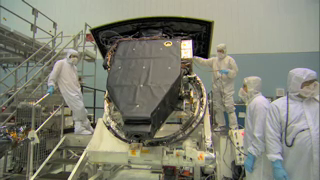|
|
 |
Wide Field Camera 3: Extending Hubble's Vision, Packed with Power
|
|

|
|
When placed on the Hubble Space Telescope, WFC3 will provide unprecedented capabilities for imaging the cosmos at near-ultraviolet and at near-infrared wavelengths. The Wide Field Camera 3 (WFC3) will study a diverse range of objects and phenomena, from early and distant galaxy formation to nearby planetary nebulae, and finally our own backyard -- the planets and other bodies of our Solar System. WFC3 extends Hubble's capability not only by seeing deeper into the universe but also by seeing simultaneously into the infrared and ultraviolet. WFC3 can, for example, simultaneously observe young, hot stars (glowing predominantly in the ultraviolet) and older, cooler stars (glowing predominantly in the infrared) in the same galaxy.
Duration: 4.2 minutes
Available formats:
320x180 (29.97 fps)
MPEG-4
20 MB
640x360 (29.97 fps)
MPEG-4
37 MB
1280x720 (59.94 fps)
QT
259 MB
512x288 (29.97 fps)
MPEG-4
358 MB
512x288 (29.97 fps)
QT
169 MB
320x240 (29.97 fps)
MPEG-1
67 MB
512x288 (29.97 fps)
MPEG-4
66 MB
320x180
PNG
94 KB
160x80
PNG
61 KB
80x40
PNG
17 KB
960x540 (29.97 fps)
MPEG-4
151 MB
How to play our movies
|
|
|
Back to Top
|
|
|
|